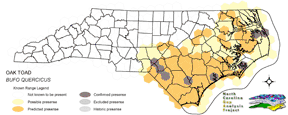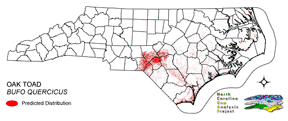
| Taxa: |
| Order: |
| Family: |
| Amphibia |
| Anura |
| Bufonidae |
| NatureServe Global Rank: |
| NatureServe State (NC) Rank: |
| G5 |
| S3S4 |
| Federal Status: |
| NC State Status: |
| --- |
| W1,W5 |


| Land Unit |
| US Fish & Wildlife Service |
| US Forest Service |
| US National Park Service |
| US Department of Defense |
| NC State Parks |
| NC University System |
| NC Wildlife Res. Com. |
| NC Forest Service |
| NC Div. of Coastal Mgmt. |
| Local Governments |
| Non-Governmental Org. |
| Other Public Lands |
| Private Lands |
| GAP Status 1-2 |
| All Protected Lands |
| Statewide |
| Hectares |
| 7,263.09 |
| 2,995.83 |
| 54,616.50 |
| 1,030.41 |
| 1,063.08 |
| 406.44 |
| 20,155.32 |
| 2,943.99 |
| 749.43 |
| 180.00 |
| 1,133.64 |
| 94.59 |
| 330,898.23 |
| 12,672.18 |
| 92,058.57 |
| 423,530.55 |
| Acres |
| 17,947.48 |
| 7,402.86 |
| 134,960.28 |
| 2,546.20 |
| 2,626.93 |
| 1,004.33 |
| 49,804.87 |
| 7,274.76 |
| 1,851.88 |
| 444.79 |
| 2,801.28 |
| 233.74 |
| 817,667.17 |
| 31,313.63 |
| 227,481.64 |
| 1,046,566.58 |
| % of Dist. on |
| Prot. Lands |
| 7.9 % |
| 3.3 % |
| 59.3 % |
| 1.1 % |
| 1.2 % |
| 0.4 % |
| 21.3 % |
| 3.2 % |
| 0.8 % |
| 1.2 % |
| 1.2 % |
| < 0.1 % |
| < 0.1 % |
| 13.8 % |
| ----- |
| ----- |
| % of Dist. on |
| All Lands |
| 1.7 % |
| 0.7 % |
| 12.9 % |
| 0.2 % |
| 0.3 % |
| < 0.1 % |
| 4.8 % |
| 0.7 % |
| 0.2 % |
| < 0.1 % |
| 0.3 % |
| < 0.1 % |
| 78.1 % |
| 3.0 % |
| ----- |
| ----- |
|
Occurs on barrier islands in GA (Gibbons and Coker 1978), and maybe in SC. This species historically may have been closely associated with longleaf pine (Pinus palustris) ecosystem (Reay and Mitchell 1999). Throughout its range, it is found in grassy areas of pine or oak savannas or flatwoods with sandy soils (Wilson 1995). This species breeds in shallow pools, ditches and ponds following heavy rain (Conant and, Collins 1998). It has also been reported in flooded, overgrown farm fields while breeding. Will also use vernal pools and freshwater wetlands (pocosins) (Terwilliger 1991). NATURE SERVE GLOBAL HABITAT COMMENTS: Sandy pine flatwoods and oak scrub; open pine and pine-oak woods; pine or oak savannas with sandy soils; maritime forests. Occurs on some barrier islands in South Carolina. Seems to favor open-canopied pine flatwoods with grassy ground cover. When inactive, burrows underground or hides under surface objects. Eggs and larvae develop in rain pools, ditches, cypress and flatwoods ponds, and other flooded areas. |
| Code | Name | Description | NC Natural Heritage Program Equivalent |
| 121 | Maritime Pinelands | Loblolly forests and woodlands of the outer coastal plain. | Estuarine Fringe Loblolly Pine Forest |
| 17 | Maritime Forests and Hammocks | Maritime forests and woodlands dominated by live or sand laurel oak. Estuarine Fringe forests dominated by loblolly pine. | Coastal Fringe Evergreen Forest, Maritime Deciduous Forest, Maritime Deciduous Forest |
| 97 | Mesic Longleaf Pine | Longleaf pine woodlands without a major scrub oak component. Slash or loblolly pines may be present as well. | Mesic Pine Flatwoods |
| 42 | Xeric Longleaf Pine | Sandhills including a range of longleaf pine density from predominantly wiregrass, scrub oak dominated to true longleaf pine woodland. This does not include mesic or saturated flatwood types. | Xeric Sandhill Scrub, Pine/Scrub Oak Sandhill, Coastal Fringe Sandhill |
| 46 | Xeric Oak - Pine Forests | Mixed forest dominated by yellow pines with white or northern red oaks co-dominating. | Pine Oak Heath |
|
Terwilliger, K. 1991. Virginia's endangered species. McDonald and Woodward Publishing Co., Blacksburg, VA. 170 pp.
Reay, K. K., and J.C. Mitchell. 1999. Atlas of amphibians and reptiles in Virginia (1). Richmond, VA: Virginia Dept. Game and Inl. Fisheries. Wilson, L. A. 1995. The Land Manager's Guide to the amphibians and reptiles of the South. Chapel Hill, NC: The Nature Conservancy. Hamilton, J. D. 1955. Notes on the ecology of the oak toad in Florida. Herpetologica 11:205-210. Ashton, R. E., Jr., and R. Franz. 1979. Bufo quercicus. Cat. Am. Amph. Rep. 222.1-222.2. Mount, R. H. 1975. The Reptiles and Amphibians of Alabama. Auburn University Agricultural Experiment Station, Auburn, Alabama. vii + 347 pp. Behler, J. L., and F. W. King. 1979. The Audubon Society field guide to North American reptiles and amphibians. Alfred A. Knopf, New York. 719 pp. Martof, B. S., W. M. Palmer, J. R. Bailey, and J. R. Harrison, III. 1980. Amphibians and reptiles of the Carolinas and Virginia. University of North Carolina Press, Chapel Hill, North Carolina. 264 pp. Mitchell, J. C. 1991. Amphibians and reptiles. Pages 411-76 in K. Terwilliger (coordinator). Virginia's Endangered Species:Proceedings of a Symposium. McDonald and Woodward Publishing Company, Blacksburg, Virginia. |
For more information please contact them at:
NC-GAP Analysis Project
Dept. of Zoology, NCSU
Campus Box 7617
Raleigh, NC 27695-7617
(919) 513-2853
www.basic.ncsu.edu/ncgap